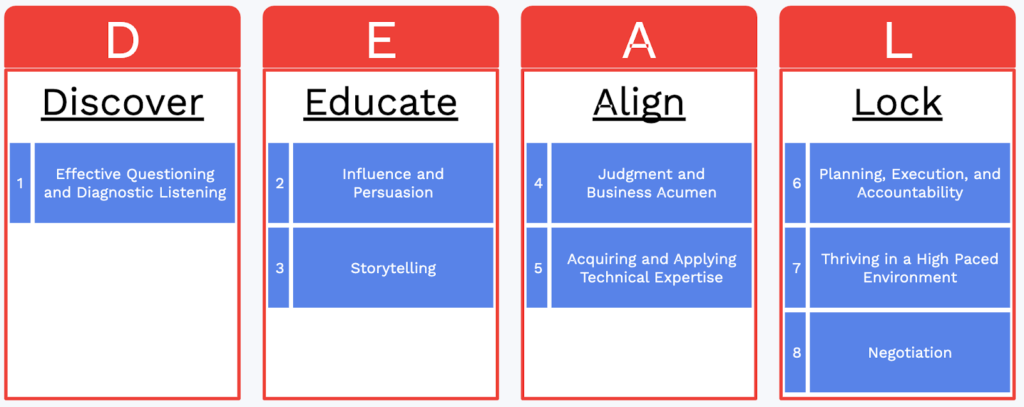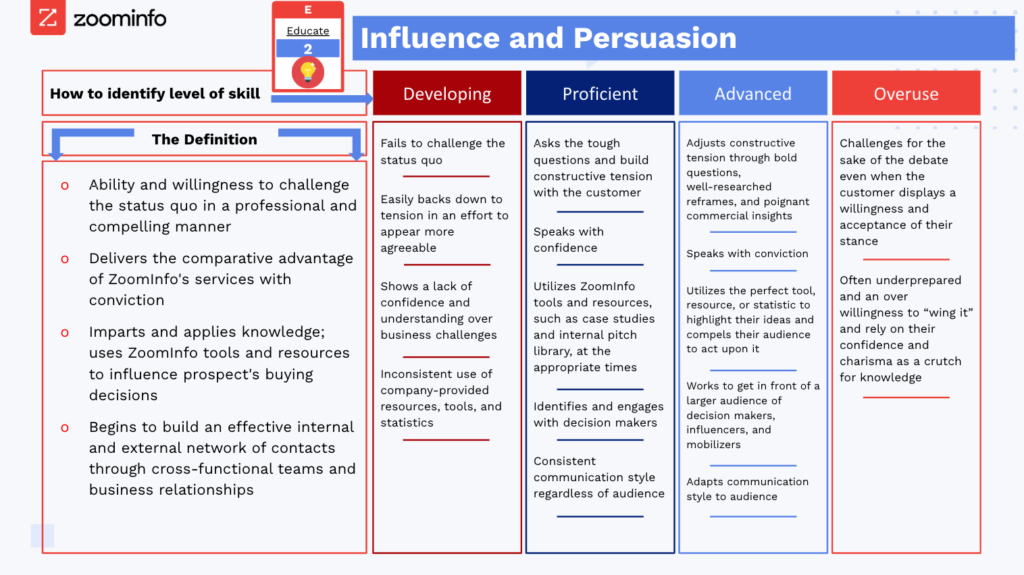B2B sales jobs have a strikingly high turnover rate.
In a study conducted by Sales Insights Lab, sales reps rated culture and management above base compensation, commission, and job flexibility.
So what if you could get people really invested in their professional development? And what if, because of this personalized development, they started to close more deals, knew what they needed to improve on for next time, and received the resources necessary to do so?
This is what a core competency sales training program aims to do: Rethink the way we approach individual and group training and make it a collaborative experience that gets buy-in from everyone involved.
What are Core Competencies in Sales?
Core competencies are essential sales skills that AEs can rate themselves on.
At ZoomInfo, sales teams follow the DEAL methodology, which stands for Discover, Educate, Align, and Lock. The core competencies provide a granular breakdown of each pillar.

Core Competencies Vs. Performance Reviews
On the surface, rating core competencies might sound to some like a performance review. But these two concepts have important differences.
Think of core competencies as a guide, rather than a report card, in which AEs are able to assess themselves and collaborate with managers on determining their baseline ratings.
“[We want] to identify where our reps are right now, where we want them to be, and where they ultimately want to be in their careers as salespeople,” says Jack Reilly, principal sales enablement manager at ZoomInfo.
These criteria were developed to get reps invested in their professional growth and foster a culture of mentorship and collaboration with sales leaders.
How Core Competencies Work
After analyzing the categories, AEs then rate themselves on each skill based on a scale of four criteria: Developing, proficient, advanced, and overuse.

Then they work with their managers to chart out the best course of action to get them where they want to be.
“It allows us to go in and — from an intimate, individual basis for specific teams — get insight into where our team believes that they excel the most and where they need the most development,” explains Ray Mariano, vice president of sales at ZoomInfo.
Benefits of Core Competencies
There are three main benefits of implementing a core competencies strategy for professional development:
1. Better Alignment Between AEs and Managers
This program ensures that sales teams and their managers are aligned on skill building and professional development. The end goal? Sales reps know where they stand and where they want to be in the future, and they’re working with their managers to bridge that gap.
When you ask people to rank themselves, you’ll get interesting results that illustrate these gaps.
“One of the things we pulled out of some of the preliminary results is that account executives rank themselves very highly when it comes to effective questioning and diagnostic listening, while their leaders actually, as a whole, did not rank them that high in that area,” explains Mariano.
2. Collaboration and Accountability
A core competency program establishes an ongoing collaborative process compared to a one-off report card for an AE. From that perspective, accountability is easier to maintain.
“I’m trying to help them develop the area that they’ve pointed out [so] that they can improve,” Mariano says. “It makes coaching a lot easier.”
When you’ve pointed out a weakness in yourself, you’re more likely to follow through on improving it, too.
3. Customization of Training
You should consider these questions when formulating a professional development program:
How can we make sure sales reps are working on what they both want and need to be working on?
How can we empower managers to become coaches in a way that is customized to the needs of their teams?
Think about it this way: General, one-size-fits-all training probably works in terms of setting a foundation for reps to use in their day-to-day selling.
However, personalized and adaptable professional development takes matters a step further and ensures that sales teams are prepared for change, growth, and scaling.
What are the Results?
A core competencies program is a long-term investment. Quantifiable results will start to emerge over the course of a quarter.
As sales reps fill out the development plans, identify areas of improvement, and put improvement plans into action, you’ll see more immediate results.
For example, here is an example of a skill breakdown that a rep and their manager would look at together in order to determine their initial skill level. In this case, it’s Influencing and Persuasion.

The program allows for room to grow as the needs of the business change and evolve.
“This is something we will keep iterating and changing as our business changes, as our team changes,” says Reilly. “No one is ever going to be the perfect salesperson.”

